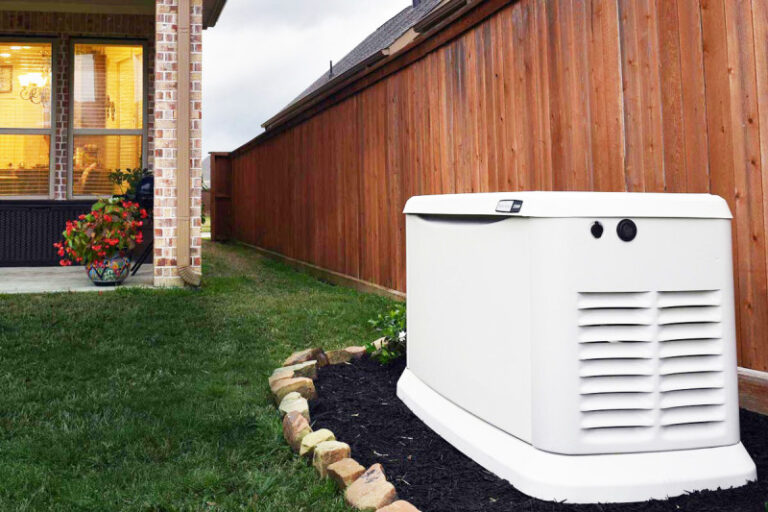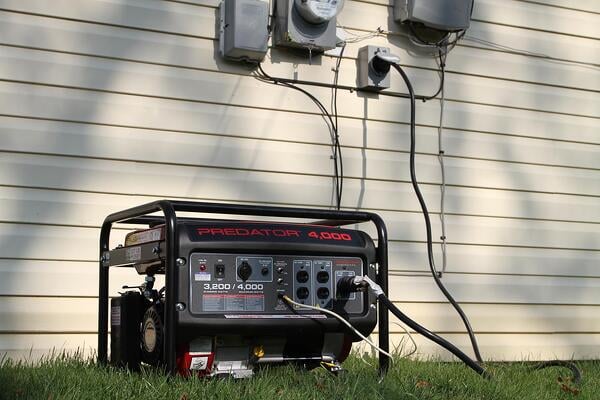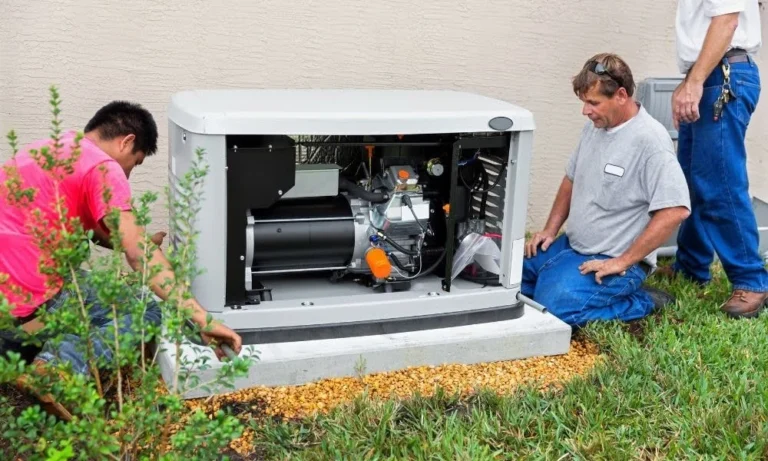Uninterrupted Power: A Guide to Connecting a Backup Generator to Your House
Imagine a scenario where you’re enjoying a calm evening at home, and suddenly, the power goes out. The convenience of modern living dissipates in an instant. We often take the constant supply of electricity that powers our homes for granted until we experience a power outage. In these situations, backup generators literally and metaphorically serve as a beacon of light, providing us with the assurance of an uninterrupted power supply.
However, choosing and installing a backup generator is more complex than it sounds. It involves understanding your power needs, selecting the appropriate generator size, and connecting it safely to your home’s power system. These are crucial steps to ensure you get the most out of your investment. This blog will provide a comprehensive guide to help you understand the importance of backup generators and key considerations before installation, ensuring you maintain an uninterrupted power supply to your home.
Understanding Your Power Needs
Before investing in a backup generator, it’s important to understand your power needs. It involves calculating the total wattage requirements of all the devices and appliances you intend to power during an outage.
To do this, you need to list all these items and their wattages, usually indicated on their labels or manuals. Once you have this information, adding up these wattages will give you an estimate of the minimum power output your generator should deliver. However, remember that some appliances, like refrigerators and air conditioners, require more power at startup, so consider a generator with a higher surge wattage.
Identifying the critical appliances in your home is also part of understanding your power needs. These appliances and systems are essential for your comfort, safety, and convenience during a power outage. They often include heating and cooling systems, refrigeration, lighting, and devices for communication. Prioritizing these appliances can help you choose a generator that meets your essential power needs without necessarily powering your entire home. This approach can make owning a generator more affordable and efficient.
Types of Backup Generators
Understanding the types of backup generators is crucial to ensure you have reliable power during outages. Let’s delve into the main types and their unique features.
Standby Generators
Standby generators are permanent fixtures installed outside your home or business. They automatically kick in when the power goes out, providing seamless, uninterrupted power. Standby generators are usually powered by natural gas or propane, making them reliable for prolonged outages.
Portable Generators
Portable generators are compact, movable units that can be used anywhere. They run on gasoline or diesel and provide temporary power during an outage or for outdoor activities like camping. However, they require manual startup and fuel refills, which are best for short-term use.
Inverter Generators
Inverter generators are a modern alternative offering quieter operation and greater fuel efficiency. They produce clean, stable power suitable for sensitive electronics like laptops. These lightweight and portable generators make them ideal for outdoor events or RV trips.
Choosing the Right Generator
Choosing the right generator involves considering factors like fuel type, size, and environmental impact. Let’s explore these aspects in detail.
Fuel Types
Generators can run on various fuels, including gasoline, diesel, propane, or natural gas. Your fuel choice can influence the generator’s cost, runtime, and emissions. It’s essential to consider each fuel type’s availability and storage requirements.
Sizing Your Generator
The size of your generator should match your power needs. Smaller units might be sufficient for occasional use or powering a few appliances, while larger ones can power an entire home. Consider the wattage of the appliances you need to power before deciding.
Noise Levels and Environmental Impact
Generators can be loud and contribute to air pollution. Inverter generators tend to be quieter and more eco-friendly than traditional models. Always check the noise level and emissions of a generator before purchasing.
Essential Tools and Equipment
Setting up and maintaining your generator requires specific tools and safety equipment. Let’s look at some essentials.
Transfer Switches
A transfer switch is vital for safely connecting your generator to your home’s electrical system. It prevents backfeeding, which can be dangerous. Depending on your generator type, transfer switches come in manual and automatic varieties.
Cables and Wiring
Proper cables and wiring are crucial for the safe operation of your generator. They must be rated for the generator’s voltage and current to prevent overheating or fire hazards. Always use manufacturer-recommended cables and wiring.
Safety Gear
Operating a generator involves handling fuel and electricity, so appropriate safety gear is essential. It includes gloves, safety glasses, and potentially a fire extinguisher. Always follow the manufacturer’s safety guidelines when operating your generator.
Ensuring Regulatory Compliance
Installing a backup generator is more than just choosing the suitable unit and setting it up. It’s also about ensuring that your installation complies with local regulations. It usually requires obtaining necessary permits from your local government or utility company before installation. The permit process often involves submitting a plan detailing your generator’s type, size, and location and how it will be installed. This process ensures that your generator installation is safe and minimizes risks to utility workers during outages.
Compliance with local codes is another crucial aspect of generator installation. These codes may dictate where to place your generator, how to install the transfer switch, and what fuel storage and supply systems are permissible. Non-compliance can lead to fines, denial of permits, and even forced removal of the generator. Hiring a professional installer familiar with these codes is always advisable to ensure your installation is compliant.
Installation Process
Setting up a backup generator involves several steps, each crucial for the safe and efficient operation of the system. Let’s walk through the installation process together.
Site Preparation
Before installing your generator, it’s necessary to prepare the site. It includes choosing a suitable location that’s flat, easily accessible, and safe from flooding or excessive moisture. The site should also comply with local building codes and regulations.
Installing the Transfer Switch
The next step is installing the transfer switch, which safely connects your generator to your home’s electrical system. An electrician should perform this task to ensure proper installation and compliance with electrical codes. Remember, a correctly installed transfer switch prevents backfeeding, which can be dangerous.
Connecting the Generator
Once the transfer switch is installed, you can connect the generator. It involves running electrical conduits between the generator and the transfer switch and fuel lines from the generator to the fuel source. Always refer to the manufacturer’s instructions for this process.
Safety Measures
Operating a backup generator involves certain risks, so following specific safety guidelines is essential. Here’s what you need to know.
Generator Placement
Generators should be placed outdoors in a well-ventilated area. They should be far from windows, doors, and vent openings to prevent carbon monoxide from entering your home. Also, ensure the generator is protected from the elements and is easily accessible for maintenance.
Ventilation Requirements
Generators produce exhaust gasses, which can be hazardous in confined spaces. Therefore, proper ventilation is crucial. Ensure your generator is in an open area where exhaust gases can disperse safely.
Regular Maintenance
Like any equipment, generators require regular maintenance to ensure longevity and reliability. It includes checking and changing the oil, inspecting the air filter, and testing the unit regularly. Always follow the manufacturer’s maintenance schedule and guidelines.
Testing and Troubleshooting
Once your generator is installed, regular testing is necessary to ensure it will work when needed. These tests should be conducted under load, meaning the generator powers some or all of your critical appliances. Regular testing verifies that the generator works correctly and helps keep the engine in good condition. Remember to follow the manufacturer’s instructions for testing and maintenance to ensure you’re not voiding your warranty.
Despite regular testing, you may encounter some common issues with your generator. These can include failure to start, insufficient power output, or unusual noises during operation. Familiarizing yourself with these common issues and their solutions can help you troubleshoot problems when they arise. Always refer to your generator’s manual for troubleshooting guidance, and feel free to contact a professional if you need clarification.
Integration with Smart Home Systems
Modern backup generators often come with features allowing integration with smart home systems. This integration can provide remote monitoring and control capabilities. You can check fuel levels, start or stop the generator, and receive alerts about potential issues from your smartphone or computer. This feature can provide peace of mind, especially if you travel frequently or have a vacation property that needs backup power.
Compatibility with home automation systems can take this convenience even further. With this feature, your generator can communicate with other devices in your home, such as smart thermostats, lights, or security systems. It means your generator can automatically adjust its output based on the power needs of these devices, improving efficiency. Furthermore, in an outage, your smart home system can prioritize power to critical devices, ensuring they stay on even if other less critical devices have to go off.
Cost Considerations
Investing in a backup generator involves considering both initial and ongoing costs. Let’s break down these cost factors.
Initial Investment
The initial cost of a generator includes the price of the unit itself, installation costs, and any necessary modifications to your property. The type and size of the generator significantly influence this cost. Always factor in these costs when budgeting for a generator.
Operating Costs
Operating costs include fuel, maintenance, and potential repairs. These costs can increase over time, especially for larger units or those that run on more expensive fuel types. Consider these ongoing costs when choosing your generator.
Return on Investment
A backup generator can provide a significant return on investment despite the upfront and operating costs. It can prevent losses during power outages, increase your property value, and provide peace of mind. Consider these benefits when evaluating the cost-effectiveness of a generator.
Summary
Having a backup generator connected to your house is more than just a luxury; it’s about ensuring uninterrupted power supply, safety, and convenience. Understanding your specific power needs, adhering to local regulations, and maintaining regular tests and troubleshooting are all integral parts of the process. Each step contributes to a safe, efficient, and reliable power source during unforeseen power outages. Remember, investing in a backup generator is not merely a purchase but a commitment to preparedness and resilience.
Owning a fully functional backup generator involves careful planning, informed decision-making, and diligent maintenance. It may appear daunting initially, but the peace of mind and security it provides during unexpected power outages make it worthwhile. So, whether you’re considering a backup generator for your home or already have one, remember the importance of understanding your power needs, ensuring regulatory compliance, and exploring smart home integrations. With these steps, you’ll be well on your way to enjoying the benefits of uninterrupted power.








